We’ve just returned from the latest conference on Making Vinyl in Nashville where we asked, how long the upturn in vinyl record sales will last?
By now everyone knows that vinyl sales have increased so much, that last year they overtook CD sales and look set to continue through the rest of the year. But will this recovery last beyond next year? We met with manufacturers and vinyl factories from both Europe and the US to ask that question along with many other questions about the future of vinyl.
Why are we asking how long this will last?
Well It’s all about supply and demand. The demand for vinyl is huge. Artists want their records released on vinyl, not only for the current trend, but also for the sound, the artistic real estate the cover brings and of course the profit margin. Fans have also discovered the sound and the collectability of vinyl - an analogue sound that reverberates, which is way better than its digital counterpart. Physically holding on to an album with an amazing cover design offers a different high and it could easily become collectible, increasing in value depending on the artist and condition.
Supply is another matter though. With the downturn of vinyl sales in the 80’s many vinyl plants closed and machines were scrapped or left to decay. So as demand started to increase rapidly over the last few years, it has been difficult for the industry to recondition old machines and also find the experienced staff who understand how to work them. It’s taken some time for manufacturers to design and start building new machines and that ‘lag’ has caused the incredibly long lead times in vinyl manufacture.
Now that there are several manufacturers bringing machines on line what is the scope for increased capacity in the market place?
The world’s largest manufacturer, GZ Media based in the Czech Republic is unique in that it builds its own machines and isn’t tied to the queue that now exists as other vinyl plant’s try to ramp-up output. The guys at GZ are of the opinion that it will take several years for supply to catch up with demand. They have just opened a factory in Nashville and also co-own plants in Memphis and Canada and feel that although capacity is increasing, the infrastructure for other plants to increase will take time to put in place. It’s not all about new machinery, you need buildings, plumbing, electricity etc. Once you have those you need to find and train staff to work the machines and then get lines up and running to a standard that will produce vinyl that is of a good enough quality for today’s consumer. Let’s face it, vinyl from the 70’s wasn’t always of the highest standard!
At least 5 other US vinyl plants that attended the conference announced that they were putting in new machines and discussion also revealed that several other US plants were doing the same along with one or two smaller operations setting up from scratch. We counted at least another 40 machines being mentioned at presentations or discussions at the conference. So we then focused on Europe and what new capacity is coming on line and discovered that at least 60 new machines are due to come online over the next couple of years. Given that 100 lines will yield around 50 million units that’s a huge increase in capacity, but is it enough to bring lead-times and prices down?
The major record labels have huge catalogues of music to exploit and the demand is still very high to recapture music from past decades. There is also a huge amount of music that was only ever released on CD and is being re-issued on vinyl for the first time. While this need from the bigger companies to re-issue old titles persists, then the capacity coming on line will be filled and the boom will continue. However, the prediction from many manufacturers is that it will plateau over the next few years, but few would be drawn on whether it will end soon after that.
One final comment was from Keynote Speaker T Bone Burnett who announced a new type of acetate which, instead of degrading after the first play, can be played a thousand times. Space technology has been used to create a new coating that can possibly change the way we use lacquers and process metalwork in the future. He has recorded a one off acetate using this ‘Ionic’material with Bob Dylan as the artist. It will be auctioned at Christies in July this year!
